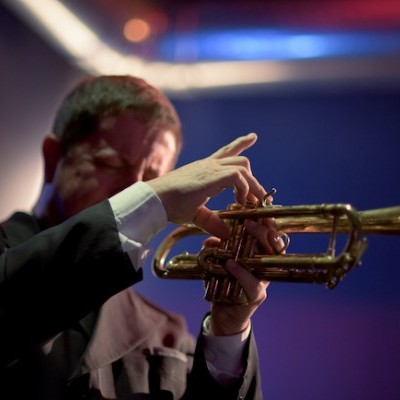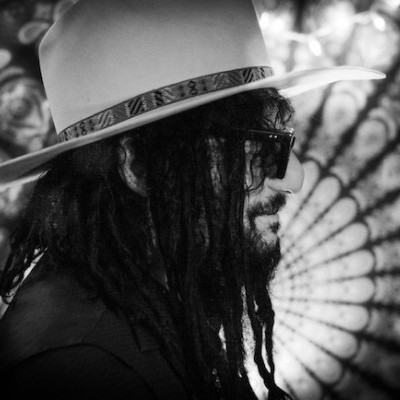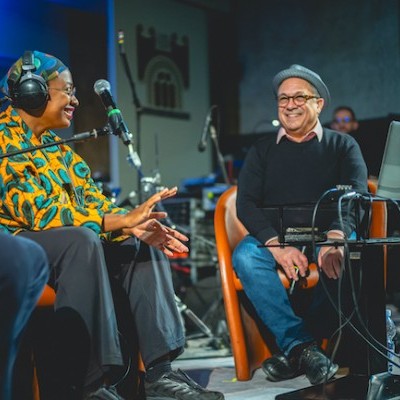Jul 9, 2024 11:35 AM
Trumpeter, Educator Jim Rotondi Dies at 61
Jim Rotondi, a renowned hard-bop trumpeter, composer and educator, died suddenly on July 7 at a hospital in France. He…
On display at New York’s Winter Jazzfest is not only a variety of styles, repertoires, concepts and generations, but seemingly every imaginable combination of instrumentation, from Miles Okazaki’s solo guitar to the 19-piece Big Heart Machine. And during the second night of the festival’s centerpiece two-night marathon, which ran Jan. 11–12, an interesting string of acts centered on two-person tête-à-têtes. These weren’t necessarily duo performances, per se, but at the core of each were the combined visions of two musicians.
That said, at least one actually was a duo. Anteloper, the merger of free-jazz trumpeter Jaimie Branch and experimental rock drummer Jason Nazary, played a taut, often eerie set at the West Village club SOB’s. Both Branch and Nazary make use of heavy electronics in Anteloper, and they began with a low groaning drone, accompanied by feathered kick drum and some space age sci-fi effects. (Except for the kick, it was hard to see who played what.) Then Branch picked up her Harmon-muted horn, let loose with a riff that crossed Reveille with the blues, and looped herself in real time, so the riff continued after she put the horn down.
Even with all these layers, Anteloper’s set quickly became richly percussive. Dripping with reverb, Branch’s trumpet thrusted and danced on Nazary’s stomping accents, both improvising over an aggressive MIDI-like beat that made the whole affair sound like a dark and twisted video game. At one point, Nazary channeled the groove of James Brown’s “Funky Drummer,” while Branch rolled out chromatically descending synth lines; these, perhaps inevitably, solidified into the Jaws theme.
Pianist Carmen Staaf and drummer Allison Miller’s Science Fair was some distance away from Anteloper: not so much in the 20-minute walk to East Village venue Subculture, but in the music. Science Fair is the pair’s post-bop quintet with saxophonist Dayna Stephens, bassist Matt Penman, and, at this gig, trumpeter Jason Palmer standing in for Ambrose Akinmusire. It is Staaf and Miller’s brainchild, however, and both performers remained central throughout the proceedings. What seemed at first a menacingly overtoned Palmer solo on “What?!” turned out to be a fierce duel with Miller. Similarly, a long, declamatory statement from Stephens actually featured Staaf in a tight-knit interplay.
The leaders’ chemistry was impressive, too. The high cerebral drama of Staaf’s piano solo on “Symmetry” was answered by a haunting low rattle on Miller’s drums. Meanwhile, on “Weightless,” they came together with Penman to develop and sustain a neck-twisting groove. Their simpatico was sealed with a funky duet on “MLW,” Miller playing traps largely with her hands, underscoring Staaf’s blue stomp of melody, written and improvised.
Then came a summit, still at Subculture, so momentous that it only could be billed as such: “JD Allen Encounters David Murray.” Yes, there was a rhythm section: bassist Ian Kenselaar and drummer Nic Cacioppo, the latter contributing a thundering solo or two. But they were nearly window dressing compared to the pairing of intergenerational tenor heavyweights. Unsurprisingly, their enormous saxophone swaggers meshed well, intensifying the already solid swing that erupted from the stage. Of the two, Allen was the more melodic, navigating labyrinthine lines with ease. But Murray had more bite, swooping far outside the forms with his gruff, loose altissimo.
Again unsurprisingly, their set together mainly was a blowing session—a high-octane and largely freeform one, with both players navigating rocky, sometimes hostile courses that the rhythm section nonetheless followed with relish. But it culminated in one absolutely transcendent moment, when Allen and Murray converged on a majestic “Body And Soul.” Murray articulated the opening bars of the theme first, and Allen followed, wrapping it in tendrils more ornate than even Coleman Hawkins attempted. It then fell back to Murray to take the first solo, during which he turned the Johnny Green melody into a rough outline for his squeals, coarsened tone and thickly coated timbre to sketch designs into. Allen, more elegant, nonetheless wandered outside the tune, like tongues of flame from the window of a burning building.
When Allen and Murray came back together for the head out, they weaved around each other like coupling snakes, broke apart with a screech to shadowbox separately, then clinched again for a warm, satisfying close.
It was the meeting of minds that any jazz fan dreams of. DB

Jim Rotondi was acclaimed for his wide, round trumpet tone, remarkable virtuosity and assured swing.
Jul 9, 2024 11:35 AM
Jim Rotondi, a renowned hard-bop trumpeter, composer and educator, died suddenly on July 7 at a hospital in France. He…

Charles Lloyd, seen here at the 2024 New Orleans Jazz & Heritage Festival, makes DownBeat Poll history!
Jul 11, 2024 12:23 PM
The incomparable Charles Lloyd swept the 72nd Annual DownBeat Critics Poll, becoming the first artist ever to earn…

“Being president of Blue Note has been one of the coolest things that ever happened to me,” Was said. “It’s a gas to serve as one of the caretakers of that legacy.”
Jun 4, 2024 12:21 PM
Sitting with Don Was is a comfortable and unhurried exercise. He may seem slightly reserved at first, but ideas and…

“She reminds me of my childhood and makes we want to cry,” Cécile McLorin Salvant, pictured here with writer Ashley Kahn, said of Dianne Reeves.
Jun 11, 2024 12:31 PM
Italy’s Umbria Jazz Winter is one of those rare annual festivals that not only coincides with a major holiday —…

Maria Schneider said of Decades, her new compilation release: “I just wanted to create something, put it in a beautiful box and say, ‘Look at what we did.‘”
Jun 18, 2024 12:00 PM
Maria Schneider opened the sleek black box and placed it on a coffee table in her Manhattan apartment. Inside lay the…